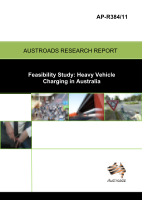Freight

Feasibility Study: Heavy Vehicle Charging in Australia
- Publication no: AP-R384-11
- ISBN: 978-1-921709-76-0
- Published: 1 June 2011
- PDF (free) Download
This report presents the findings of a Feasibility Study, conducted by Rapp Trans on behalf of Austroads, into procedural, technical and market issues associated with potential business models to support the reform of heavy vehicle charging in Australia within the framework of the COAG Road Reform Plan (CRRP) agreed by the Council of Australian Governments in 2007.
- 1. INTRODUCTION
- 1.1. Purpose
- 1.2. Scope
- 1.3. Methodology
- 1.4. Outline
- 2. KEY DESIGN QUESTIONS
- 2.1. Policy
- 2.2. Charged Network
- 2.3. Liable Vehicles
- 2.4. Legal Status
- 2.5. Charge Payer
- 2.6. Business Architecture
- 2.6.1. CESARE role model
- 2.6.2. Business architecture options
- 2.6.3. Monolithic approach
- 2.6.4. Charging Data Services (CDS) approach
- 2.6.5. Self-Assessment approach
- 2.6.6. Summary
- 2.7. Tariff Modulation
- 2.7.1. … by vehicle
- 2.7.2. … by location
- 2.7.3. … by time
- 2.7.4. … by type of load
- 2.8. Compliance
- 2.8.1. Roadside compliance check
- 2.8.2. On-board compliance check
- 2.8.3. Summary
- 2.9. Occasional Users
- 2.10. Technical Approach
- 2.10.1. Technologies
- 2.10.2. Manual systems
- 2.10.3. Roadside equipped systems
- 2.10.4. Autonomous systems
- 2.10.5. Summary
- 2.11. Interoperation
- 2.11.1. Charging interoperation
- 2.11.2. Service integration
- 2.11.3. Summary
- 3. SCENARIOS AND ASSESSMENT
- 3.1. Elaboration of options for scenarios
- 3.1.1. Purpose
- 3.1.2. Overview of options
- 3.1.3. Morphological Box
- 3.1.4. Selection of scenarios
- 3.1.5. Suitability of scenarios for vehicle clusters
- 3.2. Assessment criteria
- 3.3. Elaboration and assessment of the scenarios
- 3.3.1. Scenario 1: Paper-based Concept
- 3.3.2. Scenario 2: Monolithic Concept
- 3.3.3. Scenario 3: Edge-light CDS
- 3.3.4. Scenario 4: Edge-heavy CDS
- 3.3.5. Scenario 5: IVU-based Self-Assessment
- 3.3.6. Scenario 6: Simple IVU Concept
- 3.4. Retained scenarios
- 3.5. Conclusions from scenario evaluation
- 4. CHARGING RULES
- 4.1. Charged Network
- 4.2. Liable Vehicles
- 4.3. Tariffs
- 4.4. IVU Costs
- 4.5. Charge Payer
- 4.6. Enforcement
- 4.7. Migration
- 5. COMMON SYSTEM COMPONENTS
- 5.1. IVU
- 5.1.1. Technical components
- 5.1.2. Lifecycle
- 5.1.3. Costs
- 5.2. Other in-vehicle devices
- 5.2.1. Electronic Work Diary
- 5.2.2. On-Board Mass monitoring
- 5.3. Back-office
- 5.3.1. FBOS and CBOS
- 5.3.2. Charge assessment
- 5.3.3. Payment
- 5.3.4. User compliance
- 5.3.5. Change management
- 5.4. Charging map
- 5.4.1. Map, map-matching & tariffs
- 5.4.2. Costs
- 5.5. Vehicle clusters
- 6. HORIZONTAL ISSUES
- 6.1. Multi-application environment
- 6.1.1. Introduction
- 6.1.2. IVU interoperation
- 6.1.3. Core platform
- 6.1.4. Update and installation of applications
- 6.2. Security
- 6.2.1. Introduction
- 6.2.2. Threat analysis
- 6.2.3. Security system
- 6.2.4. Multifunctional IVU
- 6.3. Certification and auditing
- 6.4. Privacy
- 6.5. Implementation and operation
- 7. MONOLITHIC MODEL
- 7.1. Context
- 7.2. Implementation
- 7.2.1. Concept Phase
- 7.2.2. Procurement Phase
- 7.2.3. Implementation Phase
- 7.2.4. Components
- 7.3. Operation
- 7.3.1. Road Use
- 7.3.2. Charge Assessment
- 7.3.3. Back-office Operations
- 7.3.4. IVU Management
- 7.3.5. Interoperation
- 7.3.6. User Compliance
- 7.3.7. Change Management
- 7.3.8. Programme Supervision
- 8. CDS MODEL
- 8.1. Context
- 8.2. Implementation
- 8.2.1. Concept Phase
- 8.2.2. Procurement Phase
- 8.2.3. Implementation Phase
- 8.2.4. Components
- 8.3. Operation
- 8.3.1. Road Use
- 8.3.2. Charge Assessment
- 8.3.3. Back-office Operations
- 8.3.4. IVU Management
- 8.3.5. Interoperation
- 8.3.6. User Compliance
- 8.3.7. Change Management
- 8.3.8. Programme Supervision
- 9. SELF-ASSESSMENT MODEL
- 9.1. Context
- 9.2. Implementation
- 9.2.1. Concept Phase
- 9.2.2. Procurement Phase
- 9.2.3. Implementation Phase
- 9.2.4. Components
- 9.3. Operation
- 9.3.1. Road Use
- 9.3.2. Charge Assessment
- 9.3.3. Back-office Operations
- 9.3.4. IVU Management
- 9.3.5. Interoperation
- 9.3.6. User Compliance
- 9.3.7. Change Management
- 9.3.8. Programme Supervision
- 10. COSTS
- 10.1. Cost categories
- 10.1.1. CAPEX
- 10.1.2. OPEX
- 10.2. Cost items of the business models
- 10.2.1. Monolithic model
- 10.2.2. CDS model
- 10.2.3. Self-assessment model
- 10.2.4. Preliminary conclusion
- 10.3. The Rapp Trans cost model
- 10.3.1. Source of the model and values
- 10.3.2. Structure of the cost model
- 10.3.3. Limitations of the cost model
- 10.4. Assumptions
- 10.5. Results
- 10.5.1. Implementation costs
- 10.5.2. Operating expenditure
- 10.5.3. Income statement approach
- 10.5.4. Sensitivity analysis
- 10.5.5. Costs for compliance checking and enforcement
- 10.5.6. IVU costs
- 10.5.7. Costs for the User
- 10.6. Conclusions
- 11. COMPARATIVE ASSESSMENT
- 11.1. Existing tolling environment
- 11.2. Benefit to other applications
- 11.3. Costs
- 11.4. Implementation risk
- 11.5. Road usage data
- 11.6. User acceptance
- 12. CONCLUSION AND RECOMMENDATIONS
- 12.1. General conclusion
- 12.2. Main findings and recommendations
- 12.3. A vision
- 12.4. Concluding remark
- APPENDIX 1: KEY FIGURES KEY FIGURES KEY FIGURESKEY
- APPENDIX 2: TERMS AND ABBREVIATIONS
- APPENDIX 3: AUSTRALIAN VEHICLES AND TRAILERINVENTORY
- APPENDIX 4: COST FIGURES
- REFERENCES
Related publications
WEB-Telematics-Framework-23
WEB-PROJECTS-23
Latest Freight News
